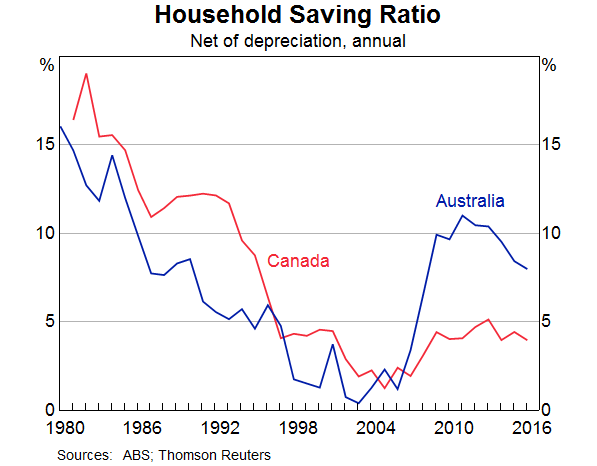
For those wondering why despite global markets trading at all time highs, consumer spending has yet to show a substantial pick up, Reserve Bank of Australia governor Philip Lowe has some ideas. Speaking at the Asutralia-Canada Economic Leadership Forum, in which he provided various comaprisons between the Australian and Canadian economies and monetary policies, the central banker warned that, "there are some signs that debt levels are affecting household spending" and notes that "the household sector is coping reasonably well with the high levels of debt. But there are some signs that debt levels are affecting household spending."
In Australia, the household sector is coping reasonably well with the high levels of debt. But there are some signs that debt levels are affecting household spending. In aggregate, households are carrying more debt than they have before and, at the same time, they are experiencing slower growth in their nominal incomes than they have for some decades. For many, this is a sobering combination.
As a result, Lowe says that the RBA's latest forecasts "were prepared on the basis that growth in consumption was unlikely to run ahead of growth in household income over the next couple of years; in other words the household saving rate was likely to remain constant. This is a bit different from recent years, over which the saving rate had trended down slowly."
He adds that "in relation to the risks from additional borrowing, it is possible that continuing rises in indebtedness, partly as a result of low interest rates, increase the fragility of household balance sheets. If so, then at some point in the future, households having decided that they had borrowed too much, might cut back consumption sharply, hurting the overall economy and employment. It is difficult to quantify this risk, but it is one that is difficult to ignore."
In relation to the risks from additional borrowing, it is possible that continuing rises in indebtedness, partly as a result of low interest rates, increase the fragility of household balance sheets. If so, then at some point in the future, households having decided that they had borrowed too much, might cut back consumption sharply, hurting the overall economy and employment. It is difficult to quantify this risk, but it is one that is difficult to ignore. As I said, our focus is on the medium term, not just the next year or so.
Lowe also looks at the interplay between rising inflation and wages and warns that while the central bank expects inflation to "gradually increase", a pick-up in wage growth is not imminent.
In our risk management exercises, we have been seeking to balance the risks from having inflation low for a longer period against the risks from attempting to increase inflation more quickly, which would partly occur through encouraging more borrowing. If inflation is low for a long period of time, it is certainly possible that inflation expectations adjust, making it harder to achieve the objective. At the moment though, I don't see a particularly high risk of this in Australia. The recent lift in headline inflation is helpful here and most measures of inflation expectations are within the range seen over recent decades.
We are both expecting inflation to increase, but only gradually so. In our case, we expect the disinflationary effects of the earlier decline in commodity prices and the competitive pressures in retailing to wane. Some pick-up in wages growth is also expected, although wage increases are likely to remain below average for some time yet. Our liaison with businesses does not suggest that a pick-up in wage growth is imminent, but nor does it suggest that a further slowing is in prospect.
He also touched on the topic of rising housing prices, and how these are leading to greater household indebtedness:
Another characteristic that we have in common is that at a time of strong demand from both residents and non-residents, there are challenges on the supply side. I understand that zoning is an issue in Canada, just as in Australia. In some parts of Australia, there has also been underinvestment in transport infrastructure, which has limited the supply of well-located land at a time when demand for such land has been growing quickly. The result is higher prices.
We are also both experiencing large differences across the various sub-markets within our countries. The strength in housing markets in our major cities contrasts with marked weakness in the mining regions following the end of the mining investment boom (Graph 6).
[image]https://www.rba.gov.au/speeches/2017/images/sp-so-2017-02-22-graph6.gif[/image]
The increase in overall housing prices in both our countries has gone hand in hand with a further pick-up in household indebtedness (Graph 7). In both countries the ratio of household debt to income is at a record high, although the low level of interest rates means that the debt-servicing burdens are not that high at the moment.
[image]https://www.rba.gov.au/speeches/2017/images/sp-so-2017-02-22-graph7.gif[/image]
That said, we are confident that Mr. Lowe is glad that unlike the US, Australia does not have some $1.4 trillion in student loans, and rising at a rate of approximately $100 billion per year, weighing on the spending patterns of the broader population.